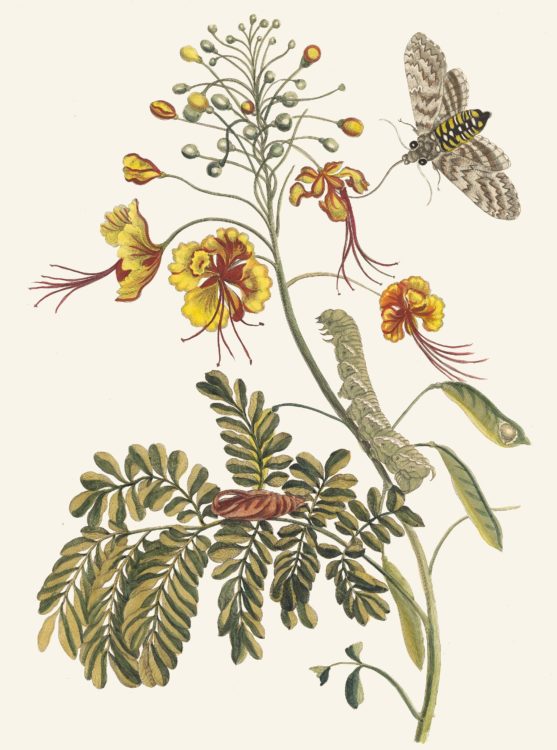From Plants to Pills: inducing abortion

Illustration of ‘Flos pavonis’ from naturalist Maria Sibylla Merian’s 1705 Metamorphosis insectorum Surinamensium (1705). Merian noted that enslaved Indians and Africans in the Dutch colony of Surinam told her they used the seeds of this plant as an abortifacient.
This month marks the beginning of the trial of Justyna Wydrzyńska, the first pro-choice activist in Poland to be charged for breaking the country’s strict abortion restrictions. Her organisation, Aborcyjny Dream Team (ADT), had previously worked around the law prohibiting anyone from ‘aiding an abortion’ by referring people abroad, where they could legally purchase the drugs mifepristone and misoprostol which can end an early pregnancy. In this instance, Wydrzyńska sent the medication herself, as the woman who contacted her was running out of time and options, having already been prevented from travelling to Germany by her abusive husband.
Misoprostol was developed in the United States in the early 1970s, where it was used to treat stomach ulcers. Known side effects included generating contractions of the uterus, leading to research on potential uses for the termination of an early pregnancy. In the 1980s, French researchers developed mifepristone, to be used in combination with misoprostol to induce abortion. This drug regime was licensed for use in 1988 in France and China, 1991 in Great Britain, 1992 in Sweden, and 2000 in the United States and the Netherlands. Called ‘medication abortion’ or ‘medical abortion’, this method has since become the one most commonly used in most countries where it is available.
Before medication abortion was available, women living in places where abortion was illegal, or in areas without abortion clinics, had to travel to access services. This added the difficulty and expense of taking time off work, often for several days for a long journey, and alongside the associated costs this often meant that only wealthier women could use this option. Since the criminalisation of abortion, beginning in the late nineteenth century, poorer women have had more limited reproductive choice, unable to afford the private doctors who might agree to perform an illegal surgical abortion, and at the same time with limited access to the full range of contraception available.
A broad array of reformers have been involved in efforts to provide women with access to abortion methods over the course of the twentieth century, relying on the use of suction or surgery to remove the fetus from the uterus for most of this time. Although the women’s health movement was able to train women to provide abortions using suction methods, for the most part, medical professionals were the only people licensed to perform such procedures. However, medical oversight of reproduction, from access to contraception to intervention in childbirth, has remained controversial from the earliest years of ‘man midwifery’, through the development of the fields of gynecology and obstetrics to today.
In 1999, Dutch doctor Rebecca Gompert founded Women on Waves to bring reproductive health care via boat to the coast of countries where the procedure was prohibited. These activities also brought international media attention, bolstering the efforts of feminist activists within these countries who had been campaigning for change. In recent years, some of these countries have responded to public pressure and decriminalized abortion, including Ireland in 2018, Mexico in 2021, and Colombia in 2022. In other countries, abortion restrictions have tightened, and difficulties accessing existing services have grown. In the United States for example, anti-abortion groups have successfully pushed for legislation that severely limits the timeframe in which abortion is allowed and adds requirements to delay and deter women, such as a waiting period after requesting an abortion before one can be performed.
Building on the new possibilities offered by the availability of medication abortion, in 2005, Gompert launched Women on Web, an online service to connect women with healthcare providers to advise on the regime and monitor treatment with the drugs, which could be ordered through the internet and delivered in the mail. Aborcyjny Dream Team is one of many organisations using the same approach.
In some ways, this twenty-first century approach recalls the longer history of abortion before the distribution of information and methods was criminalized, when ending a pregnancy before the ‘quickening‘ or movement of the fetus was legal and unregulated. Although reliable and safe methods of both contraception and abortion have improved over the last one hundred years, archival traces reveal that people have experimented with methods to limit their fertility for centuries. The modern medication abortion is related to a much older tradition of exchanging knowledge of the plants and techniques that could end an early pregnancy.
Manon S. Parry, PhD, is a historian of medicine and exhibition curator, specializing in the uses of the humanities for health and well-being. She is currently Professor of Medical History at the Vrije Universiteit, Amsterdam, and Senior Lecturer in American Studies and Public History at the University of Amsterdam.



